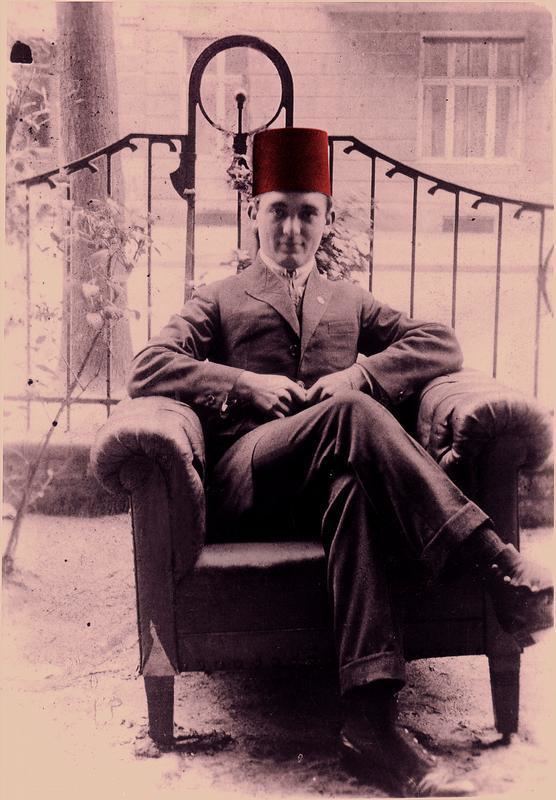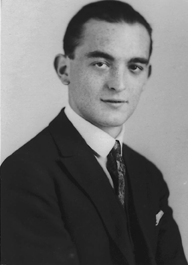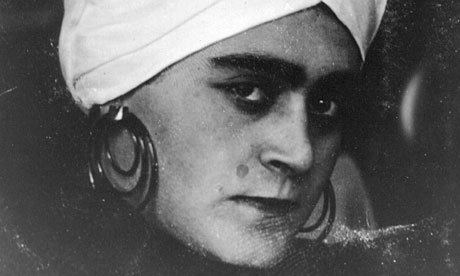Name Lev Nussimbaum | Role Writer | |
 | ||
Books Blood and Oil in the Orient | ||
Lev Nussimbaum (Kiev, October 17, 1905 – Positano, August 27, 1942), who wrote under the pen names Essad Bey and Kurban Said, was a writer and journalist, born in Kiev to a Jewish family, who spent his childhood in Baku before fleeing the Bolsheviks in 1920 at the age of 14. In 1922, while living in Germany he obtained a certificate claiming that he had converted to Islam in the presence of the imam of the Turkish embassy in Berlin. He created for himself a niche in the competitive European literary world by writing about topics that Westerners, in general, knew little about - the Caucasus, Russian Empire, Bolshevik Revolution newly discovered oil, and Islam. He wrote under the name of Essad Bey in German.
Contents

Historians and literary critics, who knew these subjects well, discredited Essad Bey as a reliable source. Today, historians disregard books published under his name and rarely quote him, though the topics Essad Bey chose to write about are still critically relevant. Furthermore, the fact that Essad Bey was so prolific calls into question the authorship of these books and whether Essad Bey was primarily operating as a broker and doctoring manuscripts and marketing them under his name, which by then had become famous. In 1934, his agent Werner Schendell warned him to slow down and take a year off between books so that he would not appear to be so prolific. That year no books appeared in German - only two novellas in Polish.

Life

Lev Nussimbaum was born in October 1905, according to himself in a train, though documents in the Kiev State Archives and the Kiev Synagogue state that Lev Nussimbaum was born in Kiev. Nussimbaum's birth was originally registered in the Kyiv Synagogue.

His father, Abraam Leybusovich Nussimbaum, was a Jew from Tiflis, in the present-day Georgia, born in 1875, who later migrated to Baku and invested in oil. His mother Berta Basya Davidovna Slutzkin Nussimbaum, according to her marriage certificate, was a Jew from Belarus. She committed suicide on February 16, 1911 in Baku when Nussimbaum was five years old. Apparently, she had embraced left-wing politics and was possibly involved in the underground Communist movement. Nussimbaum's father then hired Alice Schulte, a woman of German ethnicity to be his son's governess.

In 1918, Lev and his father fled Baku because of the massacres that were taking place in the streets. According to Essad Bey's first book, "Blood and Oil in the Orient," which historians do not consider to be very reliable, the two travelled through Turkestan and Persia. However, of this adventurous journey there is no record except in Nussimbaum's own writings. Nussimbaum and his father returned to Baku but when the Bolsheviks took Baku in the spring of 1920, they fled to Georgia where they stayed until the Bolsheviks took Tiflis and Batumi.
Lev Nussimbaum, as Essad Bey, wrote his first book Oel und Blut im Orient (Blood and Oil in the Orient) in German in 1929. Although he claims that his account was autobiographical, historians in Azerbaijan and Georgia refute the possibility as there are many major factual errors in the historical description. Essad Bey describes how as a child, aged 14, his delight in leaving Azerbaijan. In the final passage of the book, he writes: "At that moment, Europe began for me. The Old East was dead."
Then they managed to board a ship to Istanbul to where thousands of refugees had fled. Later, Nussimbaum eventually settled in Berlin (1921–1933), where he enrolled simultaneously in high school and in Friedrich-Wilhelms-Universität. He did not graduate from either, but told people that he had a Cand. Phil.
In 1926, he began writing under the pen name of Essad Bey for the literary journal Die literarische Welt (The Literary World). At least 120 articles were published under his name. By the early 1930s, Essad Bey had become a popular author throughout Western Europe, writing mainly about contemporary historical and political issues.
Politically, Bey was a monarchist. In 1931, he joined the German-Russian League Against Bolshevism, the members of which, Daniel Lazare remarks, "for the most part either were Nazis or soon would be". He also joined the Social Monarchist Party, which advocated restoration of Germany's Hohenzollern dynasty. He also had connections to the pre-fascistic Young Russian movement, headed by Alexander Kazembek.
In 1932, Essad Bey married Erika Loewendahl—daughter of shoe magnate Walter Loewendahl. The marriage failed, ending in scandal. Erika ran off with Nussimbaum's colleague René Fülöp-Miller in 1935. Erika's parents, who were wealthy, succeeded in getting the marriage to Lev Nussimbaum Essad Bey annulled in 1937.
In 1938, when the Nazi Germany annexed Austria, Nussimbaum fled to Italy and settled in the seacoast town of Positano. He died there of a rare blood disorder which causes gangrene of the extremities—most likely Buerger's disease, which is known to afflict Ashkenazi male Jews rather than Raynaud's Disease, which is more prevalent in women. It is highly likely that Essad Bey denied his Jewish ancestry from doctors who were treating him which led to his misdiagnosis of Raynaud's instead of Buerger's. Little was known in the early 1940s about Buerger's Disease, especially how the disease could be reversed if the patient stopped smoking. Tragically, Essad Bey, who was known to be a heavy smoker, died a painful death at the age of 37.
Islam
Nussimbaum had a romantic view of Islam, seeing it as part of the grand cultural heritage of "the East" (to which he felt connected by his Jewish heritage) and a bulwark against the evils of Western modernity and Bolshevism. Writing about his childhood in Azerbaijan, he notes the emotional effect he received from looking at the old palaces in Baku: "I saw the broad expanse of the sandy Arabian desert, I saw the horsemen, their snow-white burnooses billowing in the wind, I saw the flocks of prophets praying towards Mecca and I wanted to be one with this wall, one with this desert, one with this incomprehensible, intricate script, one with the entire Islamic Orient, which in our Baku had been so ceremoniously carried to the grave, to the victorious drumbeats of European culture.... Throughout my entire childhood, I dreamed of the Arabic edifices every night... I do know that it was the most powerful, most formative feeling of my life."
Confusion surrounds the details related to Essad Bey’s conversion to Islam. There are at least three accounts that attempt to explain his alleged conversion:
(1) That when Essad Bey was 17 years old, he officially obtained a certificate as “document of proof” in a declaration to Imam Hafiz Shuku (1871-1924) of the former Ottoman Embassy in Berlin on August 13, 1922.
(2) However, later accounts circulated that Essad Bey did not actually convert to Islam but that he simply reclaimed his religious identity since he had actually been born a Muslim.
(3) That Essad Bey converted to Islam along with his family when he was eight years old.
In 1924 in Berlin he helped found an Islamic student group Islamia, where he met other Muslims—Arabs, Turks, Iranians, Afghans and Indians as well as converts like himself—and "spoke out about the wretched situation of Muslims in the colonial world." However, some Muslims objected to the way Nussimbaum depicted Islam in his writings, accusing him of Orientalism and of not being a "real" Muslim. In 1930, Mohammed Hoffman, a member of Islamia and himself a convert to Islam, accused Nussmbaum of trying "to pass for a born Muslim" and suggesting that his conversion was merely a ploy. As a result of this and similar accusations, he stopped attending Islamia meetings; however, he never renounced Islam or distanced himself from it. In 1934 the New York Herald Tribune ran a profile of "Essad Bey" which described him as an irreverent Muslim who "carries no prayer rug; he fails to salute Mecca when he prays... eats pigs and drinks wine; yet when he came to be married in Berlin he refused to abjure his creed."
Armin Wegner, a contemporary of Essad Bey and who knew him in his last years in Positano, Italy, observed that Essad Bey "kept up the comedy of being Muslim to the end."
Also a scathing review of Essad Bey's biography "Mohammed" expressed doubt that the author" had ever read the Quran, either in the original or in translation." It claimed: "Essad Bey's Mohammed is a potpourri of bad history distorted facts and naive interpretations. It should never have been written... In fact, I am impelled to go still further and state that there is hardly a page in this 'biography' which is free from error."
Works
Despite Nussimbaum's being an ethnic Jew, his monarchist and anti-Bolshevik politics were such that, before his origins were discovered, the Nazi propaganda ministry included his works on their list of "excellent books for German minds". Among the works credited to him are early biographies of Lenin, Stalin and Czar Nicholas II, Mohammed, the Prophet and Reza Shah of Iran. All these "biographies" were allegedly written between 1932 and 1936. At one point, Nussimbaum was requested to write an official biography of Benito Mussolini. Essad Bey's works, many of which he claimed were biographies, are discredited by historians and literary critics and rarely referenced today except to point out how unreliable they are.
Ali and Nino
Tom Reiss attributes the 1937 novel Ali and Nino: A Love Story to Lev Nussimbaum. Ali and Nino was published under the pseudonym Kurban Said. Tom Reiss, in the book The Orientalist (a biography about Nussimbaum), argues that Said was Nussimbaum's pseudonym, and the work was written directly by Nussimbaum.
Reiss also debunks claims put forward by the heirs of Austrian barronness Elfriede Ehrenfels who claimed co-authorship. Reiss argues that she registered the book with German authorities in Austria at the time (after 1938), this was because Nussimbaum could not have received money for publishing the book in Germany due to his Jewish heritage.
Other critics, however, have shown that the book partially plagiarized and have constructed a hypothesis that it was adapted by Nussimbaum from a hypothetical earlier manuscript. A 2011 issue of Azerbaijan International re-opened the issue of the authorship of Ali and Nino. Its predominant author, Betty Blair, states that "we are convinced" that the book was primarily written by Azerbaijani author Yusif Vazir Chamanzaminli, though they also bring forward evidence that Nussimbaum wrote at least some portions of the book.
Their arguments include the claims that the folkloric and legendary passages include exact "cut and paste" passages that were published in Nussimbaum's earlier works, over and over again, as was his practice, as well as the fact that Nussimbaum left the Caucasus when he was only 14 years old and that he boasted that he was a Monarchist when the novel clearly supports the views of someone who sought the independence of Azerbaijan. Reiss dismissed the claim that Chamanzaminli was the author behind the Said pseudonym claiming that he looked at one of Chamanzaminli's novellas and found him to be a (Muslim communalist) nationalist. Betty Blair of Azerbaijan International argues, in contrast, that Ali and Nino is a "nationalist" book in a broader, non-communalist sense since the novel is essentially about Azerbaijan's independence.
In addition, Tamar Injia published a book entitled Ali and Nino – Literary Robbery!, showing that substantial portions of the book were "stolen" from the book The Snake's Skin by Georgian author Grigol Robakidze. Injia analyzed the two books, and found a number of similar and identical passages, and concluded that "Kurban Said" (whose real life identity she does not attempt to determine) deliberately transferred passages from Robakidze's earlier novel.
